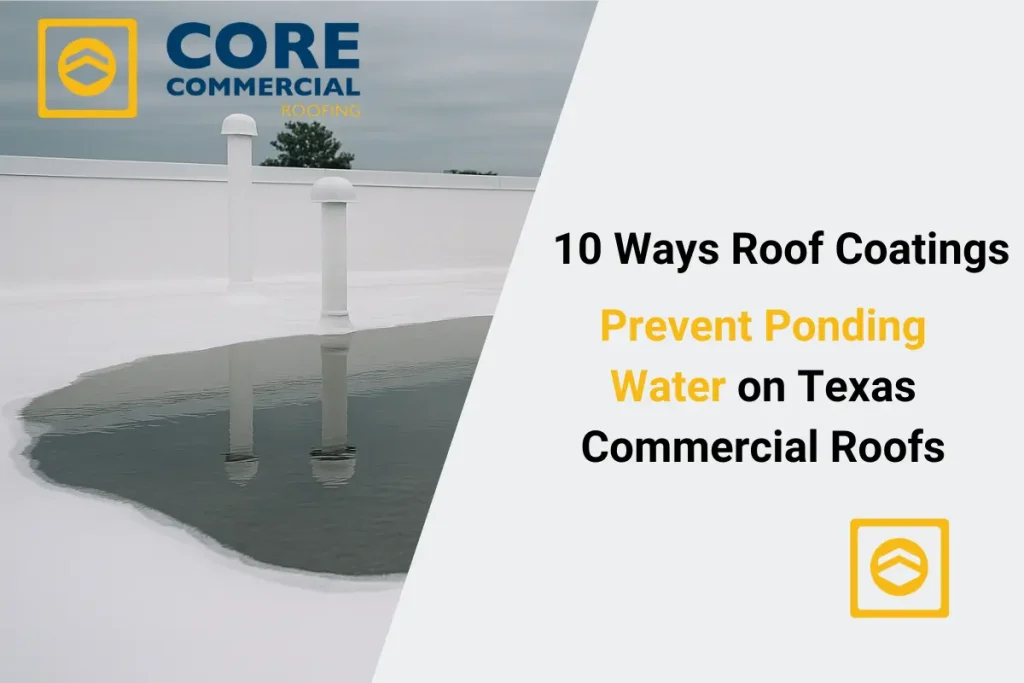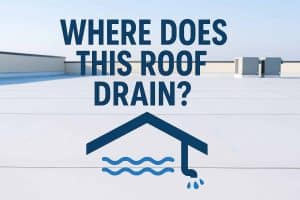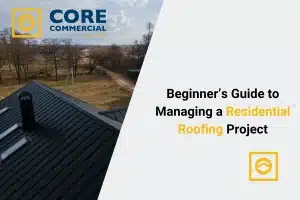Ponding water on flat commercial roofs is one of the leading causes of premature roof failure, especially in areas with intense heat and sudden storms. It weakens roofing materials, creates costly leaks, and endangers your building’s structural integrity. If your property is showing signs of standing water after heavy rains, it’s time to act.
One proven solution? Roof coatings. When applied correctly, they form a waterproof, durable surface that stops water from sitting still and doing damage. Whether your business is anywhere in a high-risk region, roof coatings can help you avoid expensive repairs and extend the life of your investment.
In this article, we’ll break down 10 simple but powerful ways roof coatings prevent ponding water and protect commercial roofing systems—all explained in clear language that’s easy to understand.

Table of Contents
Why Ponding Water Is a Big Deal
Commercial buildings with flat or low-slope roofs naturally struggle with water drainage. When rainwater stays on a roof for more than 48 hours, it becomes a problem known as “ponding.” This leads to leaks, structural wear, mold growth, and in severe cases, roof collapse.
In areas like Midland, where extreme sun and sudden downpours are common, ponding is more than an occasional nuisance. It’s a year-round threat. That’s why proactive solutions like high-quality roof coatings are essential.
You may try our high-quality commercial roof coating service
1. Creates a Smooth, Seamless Surface
Roof coatings form a continuous membrane over your existing roof. Unlike traditional materials with seams and joints, coatings eliminate cracks, tiny gaps, and weak points where water could collect or seep in. A smooth, seamless layer makes it harder for water to settle in one place.
How It Helps:
- Eliminates dips and low spots that trap water.
- Seals up micro-cracks and pinholes before they become leaks.
2. Enhances Roof Slope and Drainage
Some coating systems can be applied more thickly in certain areas, which helps add subtle slope to encourage water runoff. This is especially helpful for older roofs that have settled or sagged slightly over time.
Why It Matters:
- Creates better water flow toward drains.
- Reduces the chance of new ponding spots forming.
3. Reflects Heat and Lowers Thermal Stress
Excessive heat causes roofing materials to expand and contract, which over time can create small dips or cracks. Reflective coatings reduce surface temperatures by bouncing sunlight away, minimizing thermal movement and preventing the formation of new ponding zones.
Benefits Include:
- Reduces expansion and contraction damage.
- Helps lower indoor cooling costs.
- Minimizes stress on aging roof systems.
4. Seals Around Roof Penetrations
Roof penetrations like HVAC units, pipes, and vents are some of the most vulnerable areas for leaks and ponding. Coatings flow around and seal these tricky areas completely, leaving no gaps for water to sneak through or collect near.
End Result:
- Strengthens protection around high-risk spots.
- Stops water from pooling where materials meet.
5. Fills and Levels Minor Low Spots
Many roofs develop small indentations over time due to foot traffic, wear, or structural settling. Roof coatings self-level to a degree, gently filling in minor dips and reducing how much water those areas can hold.
This Helps:
- Minimize how much water can pool.
- Delay further deterioration in those spots.
6. Improves Drainage Efficiency
A coated roof has a smooth, slick surface that helps water move faster toward drains, scuppers, and downspouts. The less friction water encounters, the less likely it is to stagnate.
Especially Useful For:
- Roofs with limited slope or older drainage systems.
- Buildings with large flat areas and minimal drain points.
7. Stops Future Deterioration from Standing Water
Even if ponding water already exists, a roof coating can protect what’s underneath. It forms a tough, waterproof barrier that resists further damage—even if water sits for a while.
Long-Term Advantage:
- Buys time to make structural fixes.
- Keep your roof intact while you plan long-term solutions.
8. Extends Roof Life—Even in Harsh Weather
Ponding water accelerates aging, but roof coatings slow that process dramatically. They shield the roof from UV rays, rain, wind, and standing water all at once. Many products offer 10–20 year warranties when properly maintained.
For Business Owners:
- Fewer leaks.
- Fewer repairs.
- A longer-lasting roof for less money.
9. Compatible With Most Commercial Roof Types
Most commercial roof systems—including TPO, EPDM, metal, and modified bitumen—can accept coatings. Silicone and acrylic coatings bond well with a wide range of materials, making installation easy without tearing off the current roof.
Why That Matters:
- No need to shut down your business.
- No need to pay for full replacement.
- Much faster return to normal operations.
10. Fast, Affordable Ponding Prevention
Roof coatings are faster and more affordable than replacements. Most jobs take just a few days, cost up to 70% less than tear-offs, and cause minimal disruption to your business.
You Save On:
- Labor and disposal fees.
- Downtime and lost revenue.
- Future maintenance and energy bills.
Bonus Tip: Maintenance Is Still Key
Even with a top-tier roof coating, routine inspections and cleaning are still necessary. Check for debris blocking drains, recoat worn areas, and watch for new low spots forming after storms.
Proactive Maintenance Tips:
- Inspect your roof each spring and fall.
- Clean off leaves, branches, and dirt buildup.
- Touch up any worn or damaged coating areas.
Final Thoughts: Solve Ponding Without Replacing Your Roof
Ponding water isn’t something to ignore. Left unchecked, it can cause expensive damage and cut years off your roof’s life. But the good news is that you don’t need a total roof replacement to fix it.
With the right roof coating, your building in Midland can gain long-lasting protection against heat, rain, and pooling water. Coatings not only improve drainage but also seal weak spots, level minor dips, and boost energy efficiency.
From warehouses to office complexes in Midland, roof coatings offer a smart, affordable solution to one of the most common commercial roofing challenges.
FAQs
How can I stop water from pooling on my flat commercial roof in Texas?
To stop water pooling on your flat commercial roof in Texas, consider applying a high-quality roof coating like silicone or acrylic. These coatings create a seamless, waterproof barrier that encourages proper drainage and prevents water accumulation. Additionally, ensure that your roof has adequate slope and that drains are clear of debris to facilitate water runoff.
What is the best roof coating to prevent ponding water in Texas?
Silicone roof coatings are highly recommended for preventing ponding water in Texas due to their excellent water resistance and durability. They remain flexible under extreme temperatures and can withstand prolonged exposure to standing water, making them ideal for the Texas climate.
Can roof coatings fix ponding water on commercial roofs?
Roof coatings can help mitigate ponding water issues by creating a waterproof surface that promotes drainage. However, they are most effective when used in conjunction with proper roof design and maintenance practices. For severe ponding problems, additional structural adjustments may be necessary.
How does ponding water affect flat roofs in Texas?
Ponding water can lead to significant damage on flat roofs, including membrane deterioration, leaks, and structural stress. In Texas, the combination of intense sun and heavy rainfall exacerbates these issues, making it crucial to address ponding promptly to extend the roof’s lifespan.
Are silicone roof coatings good for Texas commercial roofs?
Yes, silicone roof coatings are excellent for Texas commercial roofs. They offer superior UV resistance, flexibility, and water repellency, which are essential qualities for withstanding the state’s harsh weather conditions. Their ability to endure ponding water makes them a preferred choice for flat and low-slope roofs.
How often should I inspect my commercial roof for ponding water?
It’s advisable to inspect your commercial roof at least twice a year, preferably in the spring and fall. Regular inspections help identify and address ponding water issues early, preventing potential damage and costly repairs. After significant weather events, additional inspections may be necessary.
What causes ponding water on flat commercial roofs?
Ponding water on flat commercial roofs can result from inadequate drainage, improper roof slope, clogged gutters, or structural settling. In Texas, heavy rainfall and debris accumulation can exacerbate these issues, leading to water pooling if not promptly addressed.
Can roof coatings extend the life of my commercial roof in Texas?
Absolutely. Applying a high-quality roof coating can significantly extend the life of your commercial roof by protecting it from UV rays, water infiltration, and thermal cycling. In Texas, where roofs are exposed to extreme weather, coatings provide an additional layer of defense against environmental stressors.
Is roof coating a cost-effective solution for ponding water issues?
Yes, roof coatings are a cost-effective solution for addressing ponding water issues. They are less expensive than full roof replacements and can be applied with minimal disruption to business operations. By enhancing waterproofing and durability, coatings help prevent future damage and reduce maintenance costs.
Do I need to replace my roof if there’s ponding water?
Not necessarily. If the ponding water hasn’t caused significant structural damage, applying a suitable roof coating and improving drainage may resolve the issue. However, if the roof has extensive damage or deterioration, a full replacement might be necessary. Consulting a roofing professional can help determine the best course of action.






